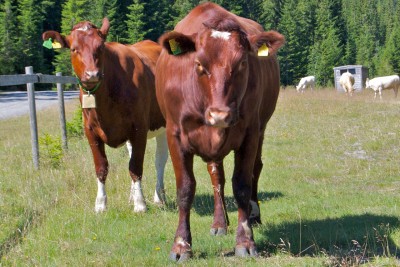Norway’s powerful farmers’ organizations handed over a demand on Friday for nearly NOK 2 billion in increased income this year, mostly in the form of higher prices for meat and more direct support in the state budget. The demand amounts to around NOK 47,000 (USD 8,000) per farmer, much higher than annual pay raises for other Norwegian labour groups this year.

State statistics bureau SSB reported earlier this spring that farmers received average pay raises of 11.5 percent from 2011 to 2012, and even Merete Furuberg, the head of one of the farmers’ lobbying groups, Norsk Bonde- og Småbrukerlag, has admitted that the average Norwegian farmer’s income rose by NOK 30,000 last year. She and her counterpart in the other large farming lobby, Nils T Bjørke of Norges Bondelag, contend, however, that another big raise is needed to recruit new farmers, to prevent farmers from giving up their operations and to ensure food production in Norway.
“Income growth in agriculture is positive,” Furuberg conceded to news bureau NTB last week as her group prepared its demand, “but as long as the distance from the income earned by other groups is as large as it is now, it’s difficult to create optimism, recruiting and investment.” She and Bjørke have claimed that average annual salaries in Norway are expected to rise to NOK 488,800 (USD 85,000) this year, while farmers’ income on average is around NOK 300,000 and most feel a need to have second jobs.
Overproduction amidst their concerns
Even though there’s been overproduction of pork, poultry and eggs in Norway, and the country is one of the biggest seafood-producing nations in the world, the farmers’ representatives nonetheless claim they’re worried about a decline in Norwegian food production. New figures show a decline in grain production, but that was mostly caused by bad weather. The farmers warn that Norway’s degree of self-sufficiency has fallen, although critics have claimed that anyone worrying that Norway doesn’t produce enough food must not view fish as food.
The money demanded by the farmers, estimated at NOK 1.97 billion (USD 340 million), would be generated in the form of, among other things, direct taxpayer subsidy and prices for meat and cheese, after the farmers received higher and controversial import tariff protection from January 1. Higher customs duties keep more imports out of the Norwegian market and allow farmers to further raise their highly regulated prices, especially now for beef and dairy products. Newspaper Dagens Næringsliv (DN) reported that there may come yet another demand for higher tariffs on imported filet of beef and lamb.
Election year dynamics
In an election year when farmers make up the biggest constituency in the Center Party, one of the members of the government coalition seeking reelection, political commentators predict the farmers will get what they want. The Labour-led government is keen to avoid more labour conflicts and farming officials promise the resulting price increases at the grocery story won’t be major.
State officials were non-committal upon receiving the farmers’ demand, but some noted that the increases sought seem high. They also stressed that the farmers themselves are responsible for production, with supply and demand still playing a role in food prices in Norway despite all the regulation. The state, agriculture officials argue, can’t be held responsible for a dip in prices for pork and some poultry products that was caused by overproduction.
Farmers’ own moves to cut production
Meanwhile, Trondheim newspaper Adresseavisen recently reported that meat cooperative Nortura is now slaughtering pigs before they have grown to what’s considered “normal” size, to consciously reduce production of pork at a time when many Norwegians seem to be preferring chicken. Pork has long been a staple of the Norwegian diet, but consumer tastes have been changing in recent years and demand for pork is down while production is up.
Jakob Simonhjell of Nortura admitted to Adresseavisen that without the early slaughtering program, “we would have had an oversupply of 6,000 tons of pork in the market, so this is an effective way to reduce production.” That raises questions about the farming lobbyists’ concerns over allegedly declining food production, given such active steps by the farmers’ cooperative to cut it on purpose.
Views and News from Norway/Nina Berglund
Please support our news service. Readers in Norway can use our donor account. Our international readers can click on our “Donate” button:

